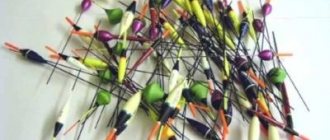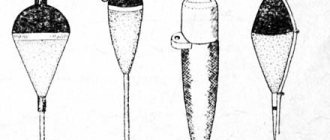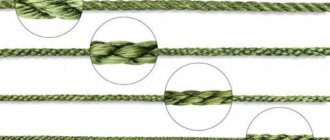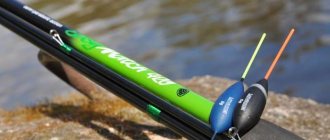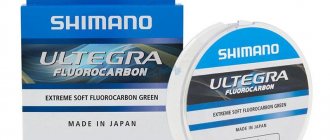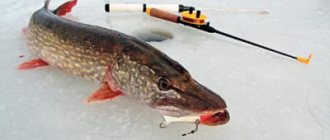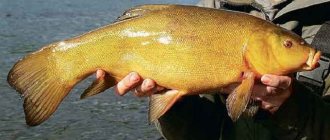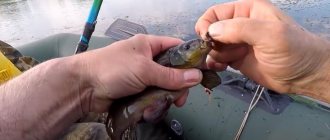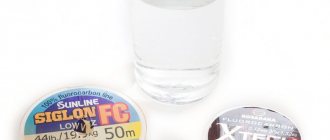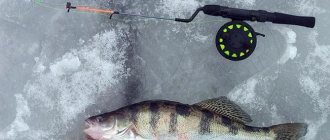Float tackle is one of the winter fishing tools. Fishing with a float in winter can be achieved with varying degrees of success, and the result depends not only on the willingness to sit over the hole for some time, but also on serious preliminary preparation.
Fishing with a float in winter can be successful both in the current and in calm water - the only difference is in the equipment of the fishing rod
Winter float tackle - general information for beginners
The differences between winter float tackle and summer tackle are not only in the size of the rod and the length of the fishing line, but in the shape and weight of the float, the method of loading, the length and location of the leashes and much more. The methods of “working” the rod, the methods of hooking and retrieving prey are also different. Here's how float fishing works in winter in general terms:
- The hook is baited with bait.
- The equipped fishing line is immersed in the water.
- As soon as the sinker touches the bottom, the float is adjusted by moving along the fishing line so that it is immersed in the water 1.5-2 cm from the surface.
- As soon as the fisherman notices even a slight movement of the float, he makes a hook - a sharp, but not strong jerk with the rod.
- Feeling with his hand the resulting load on the tackle, the fisherman begins to slowly pull out the line, bringing the caught fish to the hole.
- Trying not to touch the fishing line over the edges of the hole, the fish is pulled out of the water.
The fishing process can cause certain difficulties, since even a slight touch of a thin fishing line to the edge of the ice can cause it to break and lose the catch.
Float winter fishing rod includes:
- fishing rod (consists of a whip and a handle);
- coil (possibly);
- stand (possibly);
- fishing line;
- sinker and (or) prop;
- leashes (possibly);
- float;
- baited hook or jig.
The leash is included in the gear with a caveat, because there are some fishing methods in which a leash is not used.
Winter fishing rod setup.
Winter fishing rod
The reel and stand are also included with a caveat, because, for example, a “filly” fishing rod has neither a stand nor a reel.
Winter float fishing rod - video lesson for beginners:
Possible options
To attach the fishing line to the reel, you must have fishing line, any type of reel, wire cutters or scissors. Among the huge variety of methods, there are several methods that have proven to be highly effective and fundamental. It is with practicing these methods that a novice fisherman should start.
Arbor Knot
Reliable way. This method is used to attach fishing line to the spool. It is permissible to use backing. First you need to wrap the line around the reel once. A simple loop is then worked around the main end. Then a knot is tied at the end of the fishing line. Finally, you need to tighten it. The efficiency of use on braided wire is low. Using a node for backing is effective.
Self-tightening loop
One of the most used types of attaching fishing line to a reel due to its ease of manufacture. They are reliable and simply tighten when pulled. The process takes a little time and consists of several stages:
- The line wraps around the spool.
- A loop is made at the free end.
- The base of the loop, the main line, is wrapped with the free end.
- Finally, the free end is threaded through the top of the loop. Then the resulting knot is moistened and tightened. Excess fishing line is cut off with wire cutters.
[THERE IS AN ANSWER] How to catch roach in the summer using a float rod?
The main advantage is ease of manufacture and high efficiency of use. To make a loop you don’t need to have a lot of equipment or any skills. Even a novice angler can tie a fishing line to a reel in this way. The tightening force of the knot directly depends on the mass of the load. The greater the weight, the more the noose tightens.
The popularity of the self-tightening loop is due to the fact that there is no likelihood of spontaneous untangling. The loop can only be untied manually.
Silk knot
The second name is “self-tightening figure eight”. A suitable option for attaching fishing line to the spool. The production of a unit includes several stages:
- One turn of the line is made around the reel spool.
- The free end is then wrapped around the main end.
- The two ends obtained are wrapped in a manufactured loop.
- The free end is pulled through the first loop, after which the resulting knot is tightened.
The main requirement for attaching fishing line to the base of the reel is that the knots being made do not have stretchability. If the line is attached to the reel spool, the knot should be located at the bottom of the spool to avoid frequent contact with the line. The knot made should not prevent the line from rewinding during the process of casting bait.
In order to avoid discomfort during long casts, it is worth filling the spool with fishing line 1 - 2 mm below the cut.
The simplest and most common knot for tying fishing line to the spool spool is the self-tightening one. It has another undeniable advantage - reliability. But that's not all! Such a knot can be stretched under load, and the more often you cast the bait over a long distance until it completely unwinds, the tighter the loop tightens.
How to choose a fishing rod for winter float fishing
The main components of any winter tackle rod are a short flexible whip and a thick handle.
Rings for passing fishing line can be placed on the whip and a nod can be attached. The handle is made of light, non-sinking material. For factory products it is light plastic or cork, for homemade rods it is thick foam or wood.
In some regions of Siberia, birch bark boiled in boiling water is used to make a handle. Under the influence of high temperature, the bark is rolled into a dense roll, from which, after cooling, any object can be cut. The result is a light and dense handle that prevents the tackle from sinking when falling into the water. The difference between fishing rods is the presence or absence of a reel for fishing line.
- "Filly" - this is a design that has two supports located in the front and rear parts of the handle from the bottom, which make the handle look like a sports horse. The supports have a dual purpose - directly as supports and as a place for winding the fishing line during storage. Some types have a protrusion on top, which is also intended for winding fishing line. Often such fishing rods are made with a removable whip.
Fishing filly - «Balalaika“- this design has a whip built directly into the reel body, and it also performs two functions - it serves as a handle and a line storage. It can “work” both with jigs (reelless and with a nozzle) and with floats. The rod can be equipped with rings.
Fishing rod for winter float fishing - balalaika type - Fishing rods with mounted reels. The reels on such fishing rods can be easily removable, and the whips have removable rings. Such solutions allow you to make the fishing rod collapsible and compact.
All of these designs have the ability to attach a nod to the end of the whip, and to pass the fishing line, instead of rings, you can use cambrics.
After choosing a fishing rod, you can begin installing a winter float fishing rod. To do this, you need to select the necessary equipment for it.
How to tie fishing line to the spool of a reel
Not everyone knows how to do this correctly and efficiently. There are some anglers who generally prefer to ignore any knots and reel in a couple of hundred meters, explaining that they are unlikely to ever cast the bait over such a significant distance anyway. But this method does not justify itself.
This is due to the fact that by the end of the season the length of the fishing line can be greatly reduced due to its breaks, the formation of “beards”, cutting off an area that has become unusable, and so on. As a result, one day she may fly away into the unknown along with an expensive bait tied to her.
It is best to tie the fishing line to the reel spool with a knot that meets these characteristics:
- the knot should be such that it does not prevent the line from freely unwinding from the reel spool at the moment of casting the bait;
- in the event that the line unwinds to the end during a long cast, the knot must withstand and not come undone.
The simplest and most common knot for tying fishing line to the spool spool is the self-tightening one. It has another undeniable advantage - reliability. But that's not all! Such a knot can be stretched under load, and the more often you cast the bait over a long distance until it completely unwinds, the tighter the loop tightens.
How to properly tie fishing line to the reel spool with a self-tightening loop
We tie the fishing line to the spool of the spinning reel in 5 stages:
Anyone can master this method, even those who have never tied a single knot in their life before. It is not only simple and reliable, but also requires very little time, which is especially important when you are on a pond. This knot is suitable for both spinning and float fishing.
Finally, I would like to say that when winding the fishing line onto the spools, you need to stop two to three millimeters from its edge. With this winding, the line will be easier to slide off the spool and fly to its maximum length.
Then you need to make 3-4 turns of the fishing line at the very base of the spool and bring out the tip of the fishing line, as shown in the figure.
In order for the fishing line to be securely held on the spool, you need to make the right knot that cannot come undone. How to do this correctly is described in this article.
[THERE IS AN ANSWER] How to fish with a balance beam in winter?
At the initial stage, you need to take the fishing line and make one turn around the spool. In this case, one end should remain of such length that it is convenient for them to knit a knot. If the end is long, it will be awkward to knit, and if it is short, the knot will not work at all.
Then, this end is thrown over the main line, forming a loop.
Then you need to make 3-4 turns of the fishing line at the very base of the spool and bring out the tip of the fishing line, as shown in the figure.
The withdrawn tip is threaded into the formed loop and the tightening of the loop begins. To be safe, it needs to be moistened with water or saliva. If this is not done, the knot will not be so strong. After tightening, you get a reliable and small knot that will never let you down. At the final stage, you need to cut off the protruding end of the fishing line as close to the knot as possible so that the fishing line does not cling to it.
In this way, you can correctly tie the fishing line to the spool. In the picture you can see what it should look like (the knot) after tightening.
If the turns turn out to be crooked, then you should rewind, and if the line runs out, then you need to add a rewind. Its quantity depends on the desire of the fisherman and on the fishing conditions. All actions should be performed carefully, since the material is very thin, durable and well stretched, which means there is a risk of injuring your fingers. Therefore, you need to cover them with a piece of cloth or a thick glove.
Reels
The equipment of a winter float fishing rod may contain reels of various types for working with fishing line. These can be axial or axial reel-handles for balalaika fishing rods or mounted open inertial or closed inertia-free reels for other types of winter gear.
Learn more about choosing a reel for winter fishing.
Lizard 65 IR - lightweight open reel for float, lure and jig fishing
Selection of fishing line - what to pay attention to?
Fishing lines for winter fishing differ from summer fishing lines in some respects. Thus, the equipment of a winter float fishing rod places serious demands on fishing lines: high strength with a small cross-section; elasticity and, at the same time, acceptable rigidity; lack of "memory".
The main difference between winter fishing line will be the “Winter” marking applied to its packaging. Fishing lines with such markings are usually thin and can break if handled improperly. There are three types of fishing lines used when equipping a winter float fishing rod: monofilament, fluorocarbon and braided.
Monofilament ones for winter fishing are the most popular, easily accessible and at the same time have high strength, good elasticity and rigidity. They can be transparent or colored.
Fluorocarbon. The main advantage of this type of fishing line is its invisibility in the water - the fish does not see such a fishing line. Fishing lines also have a number of disadvantages:
- high rigidity;
- fragility at sharp bends;
- low strength;
- high price.
Due to their high cost, such fishing lines are most often used for making leashes.
Braided lines. Cords have greater strength with a smaller diameter. A small coefficient of stretch makes the tackle more sensitive than when using other types of fishing lines. But at the same time, the lack of stretch can also be a disadvantage, especially when fishing with a short and rigid rod. You can tear the fish’s lip and break the tackle if you make an excessively sharp movement when hooking.
Plus, in the cold, braids freeze, unlike monofilament. For this reason, they are either treated with special means, or preference is given to monofilament fishing line for winter use.
One of the brands of winter fishing line:
As you can see, on the packaging of some fishing lines, the manufacturer even indicates the permissible temperature at which it should be used.
For lovers of jig fishing
The equipment of a winter fishing rod for roach in this case depends on what fishing technique the angler will use. The key feature of the reelless reel is the absence of any bait, so the installation of such equipment requires special delicacy. For those who want to acquire a simple fishing rod with a nod, you will need:
How to equip a winter fishing rod for roach if the angler prefers to fish with a jig with bait? In order for you to enjoy your catch, you should be prepared for the fact that conditions may differ significantly in different parts of the reservoir. In this case you will have to take into account:
- the shape of the jig (very often the capricious roach may simply not like the usual “pellet”);
- thickness of the fishing line (the optimal option, as already noted, is the range of 0.06–0.10 mm);
- color of the jig (it is recommended to use a dark one in shallow waters, and a light one at depth).
Tips for a fisherman: How to tie a jig for a winter fishing rod - All the nuances
Don’t forget about the weight of the artificial bait, because the nod to the fishing rod is selected taking this parameter into account.
In addition to standard ones, you can use other options for winter fishing rods - “filly” or “balalaika”. The most widespread is the latter, consisting of a reel that simultaneously serves as both a handle and a whip. Its center of gravity is slightly shifted, so the influence of the fishing rod itself on the game is minimal. The main difference between the “filly” is the absence of a coil and other moving parts. The fishing line is wound directly onto the body, which is very convenient, especially in severe frost.
Summer fishing for peaceful fish has won many hearts. Fishing with a float rig is considered a classic; fishing of this type is carried out using two types of rods: Bolognese and fly rods. The first option has guide rings along the entire length of the blank and can be used as a tool for catching large fish. The second one does not have any, and the advantage lies in lightness and mobility.
How to choose a float for winter fishing: photos of popular options
A float for winter fishing is a separate and truly limitless topic. The industry produces them in a wide variety, but experienced fishermen almost always make winter floats with their own hands. All winter floats can be divided according to the following parameters.
- Fastening on a fishing line - with a fixed attachment point, sliding, quickly replaceable and others.
- Single or compound.
- Float options that change shape when bitten.
Types of winter floats
Let's consider some types of winter floats that have original petal designs.
The “Flower” float is an interesting design for connoisseurs of winter fishing
The flower is made from polystyrene foam with your own hands; it is a float for winter fishing with petals. There can be from 3 to 6. A very sensitive alarm, it will not miss even the most careful bite. Before the bite, it is in a half-folded form, if the bite is “down”, it sinks and folds even more, when the bite is “up”, it floats up, blooming on the surface of the water.
On the left is the “up bite” position, on the right is the “no bite” position.
Float "Tulip" for winter fishing
Its design is similar to the Flower float, but its petals are curved in the other direction and it has a cone-shaped main body. The principle of operation is the same as that of “Flower”.
Made of polystyrene foam.
Float "Chamomile"
The “Chamomile” float is the second name for the “Flower” design.
Float "Butterfly"
The “Butterfly” float also belongs to the petal alarms that open when bitten and is used in winter fishing. Unlike other types, it has only 2 petals.
Like other petal floats, the “butterfly” is made of polystyrene foam.
Separation of floats by parameters
In terms of shape - here the imagination of manufacturers is limitless: barrels, cones, cigar-shaped, with or without an antenna. In principle, the shape of the float does not matter much, the main thing is that it is clearly visible in the water and does not miss a bite. For good visibility in the water, it is painted with bright colors, and for a high-quality response to a bite, it must be properly loaded.
Setting up the loading of a winter float at home in a jar
According to the method of attachment to the fishing line. The floats are non-removable - the fishing line is threaded through a through, vertical hole. It is fixed by inserting a small rod – an antenna – into the same hole.
Non-removable float, with line passing through:
Fastening at one point using cambric. The signaling device is attached using a short rod, which is inserted into a cambric pre-positioned on the fishing line.
Single point mounting:
The fastening is through and removable. The float has a longitudinal (top to bottom) slot into which the fishing line is inserted and clamped with a rod.
Floats are removable, with a slot:
Removable float with slot
Composite. Such alarms may consist of 2 to 3 parts. This design helps to separate the functionality of the float: the lower, larger part is responsible for loading, and the upper, smaller part is responsible for the response to a bite.
The hinged joint allows you to increase the area of the sensitive part - the smaller size of the upper part requires less effort to move. Therefore, this design has greater sensitivity than a single float.
Composite, double float:
The skill of many fishermen is so high that their handmade floats are difficult to distinguish from factory ones. The desire to make floats on your own is also due to the fact that a float for ice fishing made by yourself is easier to load - you can remove the “extra” weight from it even before painting.
You can make a good and sensitive float for winter fishing with your own hands:
Construction of tackle
Now let's start describing how to make a winter float fishing rod and from what elements. In order to begin assembling the gear, you need to prepare the following:
Now let's look at each element of the gear in more detail.
Fishing rod
As can be seen from the picture above, the equipment of a winter float fishing rod is based on three types of winter fishing rod designs. These are such popular fishing rods as:
- Filly. This is the name of a winter fishing rod, which has a specially shaped foam body, like the legs of a mare, which combines a handle, a reel and legs for installation on the ice.
- Balalaika. If a regular jig balalaika is equipped with legs for placing on ice, it is also perfect for float gear.
- A fishing rod with an open reel , legs and handle is most often used for mounting float gear. Thanks to the trigger stop, it easily releases the line, the legs allow you to conveniently position it above the hole, and the warm foam or neoprene handle will help you make a precise hook.
All presented winter fishing rods are equipped with elastic whips, on which pass-through elements for fishing line are placed: rings or a set of cambrics. The same tulip is often glued to the tip as on summer fishing rods.
fishing line
To equip a winter float fishing rod, a monofilament fishing line with a thickness of 0.12 to 0.18 millimeters is used. Thin diameters are used when fishing without a leash at shallow depths, and for greater depths, gear with a thicker line and leash is better suited.
The diameter of the leash is chosen depending on the intended trophy, but as thin as possible. For example, for catching roach, sometimes 0.10 millimeters will be enough, while for catching large bream, the optimal thickness is 0.14 millimeters.
Float
Floats for winter fishing are a subject for a separate discussion. There are as many designs for winter as there are for summer. Mostly fishermen make them with their own hands, although there are also good models in stores.
All floats designed to equip a winter fishing rod can be divided into several groups according to several factors:
- According to the method of fastening, the winter float can be permanent, put on the fishing line through a through channel, or easily replaceable with fastening at the bottom point or with a side slot.
- Depending on the number of bodies, there are single and composite models.
- According to the animation method, the float can be simple and drop-down, or petal-shaped.
Photo 1. The simplest float: body and antenna.
Winter fishing has its own characteristics, which force us to make floats with a complex device. The fact is that when you look into the hole from above, the vertical displacement of a simple single body in it is very difficult to track, especially with a careful bite. This is where some tricks come to the rescue.
Photo 2. Installation of the float on the fishing line.
With a composite, double or triple float, when bitten, the upper part falls on its side, which is clearly perceived by the eye, if, of course, the upper and side surfaces are painted in different colors.
With petal models, things are a little different. The fact is that such a float should be loaded so that its petals are in a half-open state. Then further opening of the petals will indicate a bite upward, and narrowing - downward or to the side.
Hook
For winter floaters, hooks of the minimum size are used so that they fit the selected bait. They are mainly made of thin wire and painted red to resemble bloodworms.
Jigs
Instead of a hook-sinker combination, a jig is often used. In this case, you don’t need to chase expensive non-reeling models, but choose a simple “pellet” or “ovinka” with a long forearm and an inconspicuous color.
The second option for using a jig is a plastic model with a fluorescent coloring, which is attached to a hanging leash. This is how some types of winter fish, in particular crucian carp, are seduced.
Loading
The classic load for winter rigging is a combination of several pellets and additional grazing. Depending on the fishing conditions, the pellets can be placed at regular intervals or concentrated at one point on different segments from the float to the pod, which is placed 4-7 centimeters from the hook.
Photo 3. The float can be loaded at home in a jar of water.
Loading the float tackle
Loading is the most important element in setting up float gear. It is best to carry out this process warmly, at home or in the winter hut.
Loading the tackle consists of selecting a sinker, or a sinker with an underlay, so that the finished fishing line with full equipment slowly sinks. In fact, loading is the selection of a weight balance between the carrying capacity of the float and the sinker.
The task of the sinker is to deliver the hook with bait to the bottom or to the required depth. The job of the float is to inform the fisherman about a bite. A float that is too powerful and a light sinker will miss the bite. A weak float will sink a heavy sinker so that the fisherman will not see not only the bite, but also the alarm itself.
The loading process goes like this: the largest load is placed just below the float, then a feeder is attached at a distance of 50-70 cm down from it. It may consist of one or several small weight pellets, and the last load should be no closer than 4-5 cm to the hook. Correct loading is the condition of the tackle when it slowly sinks and the float hangs 1.5-2 cm from the surface of the water.
Loading option
Hooks
In winter fishing, small hooks are used, because it makes no sense to tie a thick hook on a thin fishing line. Hook options for various baits are summarized in the table.
| Type of bait | Hook number |
| Barley, corn, worm | 12, 11 |
| Maggot, caddisfly | 16 – 12 |
| Bloodworm | 24 – 18 thin, painted in color |
| Dough and other soft baits | 24 – 11 with spring coil |
Installation and assembly of a winter float fishing rod
After preparing all the components of the equipment, proceed to the installation of the winter float fishing rod:
- We prepare the fishing line - its length is equal to the depth of the reservoir, multiplied by 2, plus 2-3 meters.
- We wind it on a reel.
- We pass it through the rings, put a cambric on it for the float, and another 2-3 cambrics if the whip is without rings.
- We pass it through the float if it is used as a non-removable one.
- We tie a hook or jig.
- We load using a set of shotguns.
Assembly and installation can be considered complete after 2-3 different equipment options have been prepared for the fishing rod. For example, for fishing in still water and for a reservoir with a current.
Differences in reservoirs affect the load and sensitivity of the gear. For still water, use a thinner fishing line with a hook or jig at the end. Fishing in the current requires thicker fishing line and the use of leashes, which means a more powerful float and a heavier load.
Installation of a winter float fishing rod - how to assemble the tackle step by step clearly in the video:
How to properly equip a winter fishing rod: nod, fishing line, bait
Beginners, and not only fishermen, often have questions when choosing gear for winter fishing, especially on a new body of water. Although winter gear is not as varied as summer gear, there are still different types of equipment. Their choice depends on the type of reservoir where fishing is planned, and on the fish intended to be caught.
By type of fish, you can distinguish gear for catching white fish, such as redfish, roach or bream and predators - pike, pike perch. Perch is often caught using both types of gear.
By type of reservoir, winter fishing rods for currents and for still water can be divided.
Now let’s look at the features and differences between different winter gear in more detail.
Float rod equipment for catching roach, bream and crucian carp
Equipping a winter fishing rod with a rig with a float allows you to easily switch from summer fishing to winter fishing, and does not require special, additional skills. With such tackle you can catch bream, white bream, silver bream, roach, crucian carp and perch.
For a winter float fishing rod, the following equipment is used:
I catch roach, bream, crucian carp, etc. A winter float fishing rod uses live bait - bloodworms, maggots, jigs, etc.
Installation of a winter float fishing rod is quite simple. For it, in addition to the previously listed equipment elements, we will need scissors and pliers.
That's it, the winter fishing rod is ready for use
When fishing for pike, perch and pike perch with a winter fishing rod, use a jig, spoon or balancer. For catching perch, all three types of bait are used; for pike and pike perch, the last two are a balancer and a vertical spoon.
Fishing with a jig with a nod is the most common during winter fishing. Moreover, the jig is used both with and without an attachment. In addition to perch, roach, bream, silver bream and most other white fish are caught with this tackle.
Fishing with a winter fishing rod with a jig and a nod is a fairly active fishing method that requires constant play with the bait, so the tackle should be light.
- For such a winter fishing rod, choose a rod whose handle is made of lightweight materials, cork, various dense foams, lightweight plastics, coated with thermal insulating material that does not cool your hands when fishing.
Equipping a winter fishing rod for fishing with a nod with a jig, as in the case of a float, should not cause any particular difficulties.
- We wind the fishing line onto the reel. Its length should be equal to two depths of the reservoir in this place plus a couple of meters.
- We attach a nod to the end of the rod.
- We pass the fishing line through the nod; this is done differently for different types.
- We tie a jig to the fishing line. The method of tying depends on the type of jig. For example, if witch or devil type jigs are tied vertically, then most bloodworm jigs are tied so that the hook is at an angle to the fishing line.
The balancer is a fairly new bait but has already become quite popular among anglers. A winter fishing rod with a nod and a balancer is used to catch predators. They use it to catch pike, pike perch, perch and other predatory fish.
When selecting equipment elements for such a winter fishing rod, the fish you are going to catch is very important.
- The rod, as mentioned earlier, should be fairly light, but the larger the fish you are targeting, the stiffer, stronger and longer it should be.
- The reel is selected according to the rod. If, when fishing for perch, you only need it to carry the fishing line. This can play an important role when fishing for large pike.
- The nod is used in proportion to the weight and size of the balancer. It is of significant importance as a signaling device only for perch. A pike perch or pike bite can often be felt simply by hand.
- The fishing line used is monofilament, colored. The thickness again depends on the intended fish.
Installation of equipment is not much different from that for a fishing rod with a nod and a jig.
- We wind the fishing line with double plus a couple of meters of reserve relative to the depth of the reservoir.
- We strengthen the nod. For perch - a rubber nipple or silicone tube, for pike or pike perch - a nod from a clock spring.
- We pass the fishing line through the nod.
- We tie the balancer.
- When fishing for pike, you can use a leash of about 10–15 cm made of braid.
That's it, the tackle is ready for use.
The spoon is lighter than the balancer, so the bite on it is felt more clearly. Since, as we have already said, the bite of a pike perch or pike is in most cases felt by hand, many anglers use winter tackle for trolling without a nod. In this case, a very light tackle is used as a fishing rod, which allows you to feel even perch bites.
Most of these fishing rods are made by hand. They are based on a homemade lightweight fishing rod made from a winter sports fishing rod and a carbon tip of a spinning rod or a summer fishing rod.
So, for the fishing rod we will need:
- a winter sports fishing rod of the “balalaika” type where the reel is built into the handle body;
- the carbon tip of a spinning rod or fishing rod is at least 35 cm, the main condition is that it is hollow, since the fishing line will pass inside it;
- “Moment” type glue;
- knife and scissors;
- screwdriver with a set of drills.
- We take a sports winter “balalaika” and disassemble it by removing the coil and disconnecting the whip.
- We cut the carbon tip to the length we need. If there are rings on it, carefully cut them off with a knife . There is no need to remove them using heat, since in areas of overheating, the carbon whip becomes brittle.
- From the set, select a drill whose diameter corresponds to the thickness of the butt of the carbon tip.
- We drill a hole in the top of the balalaika handle at such an angle so that the fishing line coming out of the winter fishing rod does not rub against the edges of the carbon whip. This hole can also be made manually by holding the drill in a vice.
- Using a knife, clean the edges of the hole.
- Having smeared the butt of the whip with glue, glue it into the handle.
- After waiting a couple of hours for the glue to set, we put the coil in place. All the fishing rod is ready.
In addition to the fishing rod, we will need fishing line and lures for equipment.
We use monofilament, colored fishing line. Its diameter directly depends on the expected catch. For perch it is thinner (0.15 – 0.18 mm), for pike and pike perch it is thicker, from 0.2 mm.
A wide variety of spinners are used. Due to the method of application, vertical lures are most often used during winter fishing. They come in different types and are designed for fishing at different depths and different types of fish. Small ones for perch, larger ones for pike perch and pike perch.
To make it easier to change lures while fishing, you can use a carabiner.
A winter fishing rod for trolling without a nod is equipped quite simply:
- we pass the fishing line through the hollow whip, threading it through the hole in the tip;
- we wind the fishing line onto the reel, its length should be equal to approximately two depths at the fishing site plus a couple of meters;
- tie a spoon or carabiner.
The tackle is ready for use.
Tooling errors
No one is immune from mistakes, but the ability to quickly and without losses distinguishes an experienced fisherman from a beginner. The most common mistake in rigging is the incorrect selection of the “float-sinker” pair.
The wrong choice of hook size is trying to “put” a small bait on a large hook. When preparing gear for fishing in the current, you can make a mistake in the length of the leashes and their location on the main line.
A real fisherman will never stop because of a mistake; he will try, experiment, and eventually select the necessary equipment.
Setting up - different types of loading of a winter float fishing rod
Various settings are available for different fishing conditions. Water flow or standing water, a bottom covered with algae or silt, the expected species of fish and many other factors - all this is taken into account when setting up the gear.
Float over water
An option for setting up gear for catching large fish in rivers and other bodies of water with flowing water. When setting up, it is necessary to take into account the weight of the leashes, as well as the water pressure on the tackle. It is possible to use a sliding sinker.
Large, powerful floats and heavy sinkers are used that can keep the tackle from being carried away by the current. Strong, thick main line.
Float underwater
Fishing in still or slow-moving water. It is sunk not only to prevent the float from freezing into the ice, but the main goal is high-quality, precise adjustment of the gear for catching cautious, slow-moving fish.
Equipment options
Two floats
Also intended for fishing in still water. For high-precision tuning for very weak bites. The main float carries the load from the tackle, and the small one is responsible for the bite.
Composite floats
The main task is to catch bottom and demersal species of fish. The ability to respond to both the rise and fall of the bait by the fish, as well as the movement of the bait to the side.
Loading with jig
Loading a winter float with a jig has its own characteristics. To adjust the weight of the bait and the carrying capacity of the float, the same 3-liter jar of water is suitable as when loading equipment with one sinker.
Tips for fisherman: How to choose an echo sounder for winter fishing - What to choose for fishing
When choosing winter jigs, you should take into account their difference in weight. Tungsten products are used for fishing in great depths, and tin baits are successfully used in shallow waters. The best option for a winter float fishing rod is lead jigs with bait.
Correct loading of a winter float is performed in the following sequence:
As a bite alarm for ice fishing, many people prefer to use a nod instead of miniature floats. This is a convenient choice for fishing with a retrieve at different depths from a boat or from ice, in still water or in current conditions. It makes it possible to clearly record the bite signal with a variety of wiring techniques and playing with a jig. This method is used to catch white fish - ruff, pike, perch, bream, silver bream and roach. There are several types of fishing rods suitable for winter fishing.
Types of equipment
The main rule when equipping a winter fishing rod is the impossibility of creating one, universal tackle for everything. The gear must be different because it works in different conditions.
For fishing at different depths
The best solution when fishing at unfamiliar depths is to use a sliding sinker. In this case, the sinker is attached so that it can slide freely along the main line within certain limits. Thus, by passing the fishing line through the sinker, they adjust the location of the hooks or leashes in depth.
For the current
The main fishing tool in water bodies with weak currents is considered to be a tackle with a diverting leash. At the end of the main fishing line, a load of up to 7 grams is secured in a movable “loop-to-loop” manner. The leash is tied in the same way - the leash moves freely in the loop. This type of fastening helps to change the fishing depth.
For strong and medium currents, use a “herringbone pattern” - 2-3 leashes 15-35 cm long, rigidly attached to the main fishing line. The distance between the fastenings should be 3-5 cm greater than the length of the leashes themselves.
For different fish
The breed of fish intended to be caught is also of great importance. Each breed has its own generic methods of feeding, and therefore the arrangement of gear for catching it is not very similar to others.
The roach is found at medium depths with varying topography. Use a tackle with 2 hooks - one bottom, the second - a leash, located above the bottom.
winter fishing rod rig for roach
Bream can be active at different depths. First, it “tastes” the bait and only then, after a while, swallows it. Catching bream in winter requires very fine tuning of the gear, as well as an instant reaction to the slightest movement of the float.
Crucian carp mainly takes food only from the bottom. For him, the most effective is a bottom fishing rod.
Installation of winter fishing rod equipment for perch
The question of what is the equipment for winter fishing rods with jigs should not cause any difficulties for the fisherman. Everything is much simpler than with summer gear.
According to some anglers, perch can be caught well on baitless gear. In winter, it happens that this fish is at the bottom or swims right under the ice. Although its activity is limited by low temperatures, anglers like to catch it with a jig.
Changing gear for different conditions of a fishing spot occurs with a change in the diameter of the fishing line, the size of the jig and the hook. The best fishing option is obtained with a certain ratio of fishing line and hook parameters.
The most commonly used line diameters are 0.05 mm; 0.06 mm; 0.07 mm.
When assembling a winter fishing rod with a jig for perch, you must follow some rules:
- the fishing rod should be comfortable and not freeze in the cold;
- fishing line with a diameter of 0.1 mm;
- A reelless jig is suitable, its weight is 0.3 g;
- If possible, make the nod from boar wool; it will be visible in the snow and has sufficient rigidity.
Correct rigging of a winter fishing rod with a jig - sequence of actions:
- The fishing line is wound on a reel with a length three times the fishing depth in this place.
- The nod is attached to the end of the fishing rod.
- The line is passed through the nod.
- The jig is tied to a fishing line, the devil, for example, is knitted vertically. Some baits are tied so that the hook is at an angle.
If we talk about choosing a jig for a winter fishing rod for catching perch, then this topic will be the most important for every angler. They can be for bloodworms and bloodworms with different beads and cambrics. Some believe that each fish should have its own type of bait; other anglers are of the opinion that the main thing for fish is the action of the jig.
But there is also the main thing - weight. It plays a role during wiring. If you use a heavy bait, you won’t be able to lower it smoothly. And in the current, you won’t create the desired game with a light bait. Tungsten jigs for winter fishing rods are more versatile.
Considering that perch is caught all winter, the line should hold a decent trophy. Here you need to select a diameter of at least 0.1 mm. A thicker line will spoil the play of the bait, and a thin line, for example, 0.06 mm, may not withstand it. It also deteriorates on the edges of ice.
The amount of fishing line is determined by the depth of the fishing spot. Usually they wind 10-15 meters on a reel.
Winter tackle for two jigs
The advantage of this gear is simultaneous fishing at different depths. Some fishermen mount two or three jigs on a winter fishing rod to a fishing line at once. This can only work at great depths.
The top bait is attached to the fishing line itself or to a separate leash. It is pulled onto the fishing line, a knot is tied on the shank of the hook and passed through the jig again. A heavy bait is tied to the end of this line.
Another advantage of such gear is that you can immediately test two baits, for example, bloodworms and a worm. Many variations are used, this way the catchable bait is quickly identified.
You also need to be able to control such gear as a winter fishing rod with a jig. Two jigs are held at the bottom for 2-4 seconds, then they are raised quickly or slowly. The fish most often takes one of the baits, sometimes bites occur alternately: first the upper one, then the lower one.
Large fish can also be caught with this tackle. The fishing line should be 0.17-0.2 mm.
Bait for fishing with float tackle
Bait is almost always needed. However, it is very easy to overdo it on winter fishing; the goal is to attract fish, not feed them. You need to use complementary foods in advance so that the smell from it spreads throughout the pond. The standard size of complementary foods is considered to be a volume equal to the size of the clenched fist of an adult man. The time from immersion of complementary food to the start of fishing is 15-20 minutes.
Bait is an important point in winter float fishing, but it is important not to overdo it
Float for winter fishing rod
Choosing a float is much easier than the rest of the equipment for a winter fishing rod, however, there are some subtleties here too.
The float should be bright in color so that it can be easily followed through the water, because its working position is in it. In the store you can find a huge number of floats of various colors, but fishermen are not very fond of them.
Many people prefer to make it themselves, securing it to a fishing line in a special way:
- Place the braided telephone wire onto the fishing line.
- Attach the float.
- Thread its keel into the braid.
Why is it important to keep the float underwater? The fact is that the surface of the water in the hole can freeze at sub-zero temperatures, which significantly reduces the sensitivity of the float, which is extremely important in winter fishing. This is the only rule regarding the float, because its shape, color and fastening are a matter of taste.
Winter fishing tactics
The basis of winter fishing tactics is constant experimentation and finding those components when the bite is more or less confident: you need to experiment with bait, equipment, and fishing location.
An important rule is to install as many fishing rods as you can keep track of. The fish does not take to the baited place - try in another place, and then come back. Fish is a slow “comrade” and does not like haste. Doesn’t take bait from the bottom - try raising the bait, switch to a leader rig. There are many options, you need to constantly try them - simply sitting over the hole can leave you without a catch.
In conclusion, we can say that no article, even the most practical one, will teach you how to fish better than even one outing on the ice. Communicate with experienced fishermen, watch their habits, think, experiment and luck will be on your side.

